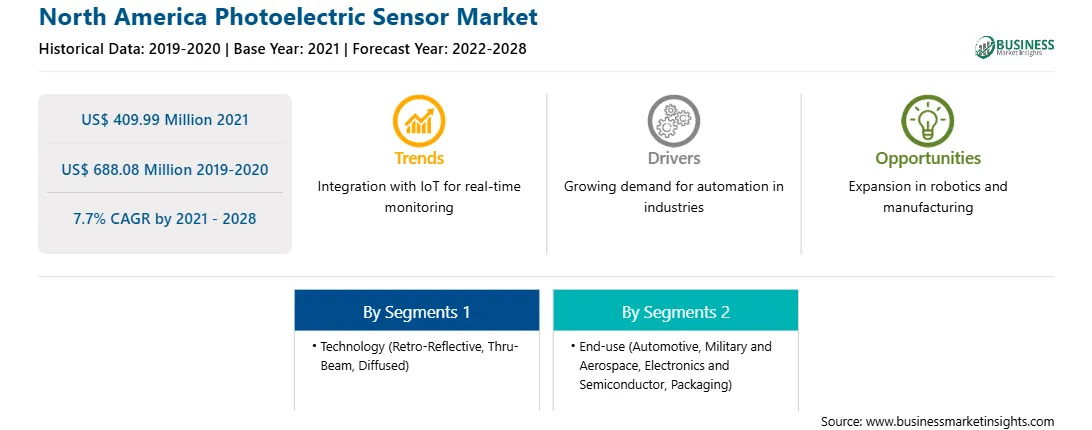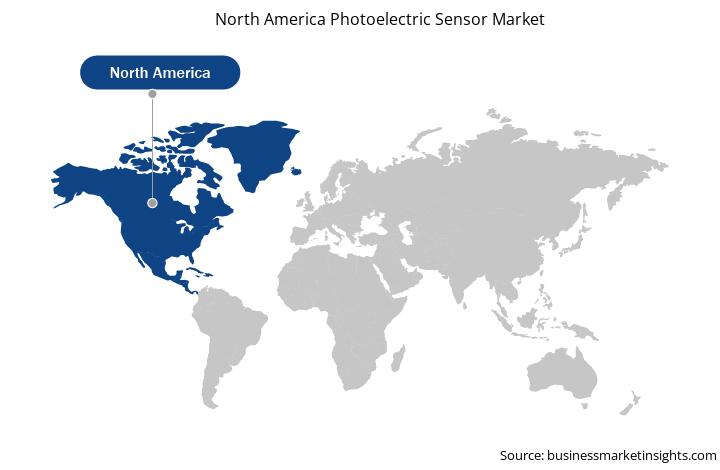2028 年北美光电传感器市场预测 - COVID-19 影响和区域分析(按技术(反射式、对射式和漫射式)和最终用途(汽车、军事和航空航天、电子和半导体、包装等))
No. of Pages: 123 | Report Code: TIPRE00024136 | Category: Electronics and Semiconductor
No. of Pages: 123 | Report Code: TIPRE00024136 | Category: Electronics and Semiconductor
北美地区制造业中越来越多的自动化实践和先进技术的采用正在产生以下需求:光电传感器可提高产品质量,减少生产过程中的错误。此外,对创新照明技术的投资也提供了强劲的行业前景。例如,芝加哥政府于 2019 年 10 月推出一项计划,到 2022 年将超过 27 万盏城市灯光更换为 LED 灯和智能照明系统,从而促进了对传感器的需求,包括环境和传感器。接近光传感器。此外,工业控制器机制对机器人的依赖目前已成为一种既定趋势,这为工业控制和工业自动化设备的更大规模和更广泛的采用铺平了道路。这使得物料搬运成为该地区增长最快的接近传感器应用市场之一。
北美是开发和采用新技术的领先地区之一;这主要归功于促进创新和加强基础设施能力的政府优惠政策。因此,对工业部门增长的任何影响都会阻碍该地区的经济增长。目前,美国是全球受新型冠状病毒肺炎(COVID-19)疫情影响最严重的国家。最近工业自动化和发展的停滞凸显了该行业对人力的依赖。预计这将展示机器人和自动化在锁定后阶段的优势,从而导致更多的采用。一旦行业达到正常运营条件,对工业自动化组件和数字化的整体需求可能会增加;在全球激烈的市场竞争中,这些技术是当前的需要。因此,光电传感器行业预计在后疫情时期将稳定增长。
北美光电传感器市场预计将从2021年的4.0999亿美元增长到2028年的6.8808亿美元;预计 2021 年至 2028 年复合年增长率为 7.7%。制药公司专注于改善整体制造运营,避免因生产线上无法提供药片而导致空包装等差异。该行业越来越多地部署光电传感器用于片剂计数、瓶子灌装和计数验证(在临床试验中)。这些传感器还用于零售药店和医院的自动处方履行机。此外,光电传感器在传感范围方面的进步,提高了计数精度,以及通过在药品包装时排除人体接触来保持卫生的生产环境,这些都是光电传感器的优点。此外,光电传感器为制药行业提供了通过自动化生产线实现的具有成本效益的解决方案。因此,制药公司采用光电传感器的激增主要归因于其提高效率、降低行业运营成本和促进实时生产监控的能力。这些传感器自动测量罐子或罐中液体的上液位和下液位。强腐蚀性化学品(酸性或碱性)的使用在制药公司中很常见,因此,储罐液位的检测是这些工厂的一项重要任务。因此,光电传感器在制药行业中的使用增加将推动未来几年光电传感器市场的增长。
从技术角度来看,2020年北美光电传感器市场中回归反射领域占据最大份额。此外从最终用途来看,汽车领域在光电传感器市场中占有较大的市场份额2020 年。
准备本报告时参考的一些主要一手和二手来源北美光电传感器市场包括公司网站、年报、财务报告、国家政府文件、统计数据库等。报告中列出的主要公司有奥托尼克斯公司(Autonics Corporation);巴鲁夫有限公司;伊顿公司;易福门电子有限公司;欧姆龙公司;罗克韦尔自动化公司;松下公司;西克股份公司;施耐德电气公司;和 Keyence Corporation 等。
Strategic insights for North America Photoelectric Sensor involve closely monitoring industry trends, consumer behaviours, and competitor actions to identify opportunities for growth. By leveraging data analytics, businesses can anticipate market shifts and make informed decisions that align with evolving customer needs. Understanding these dynamics helps companies adjust their strategies proactively, enhance customer engagement, and strengthen their competitive edge. Building strong relationships with stakeholders and staying agile in response to changes ensures long-term success in any market.

| Report Attribute | Details |
|---|---|
| Market size in 2021 | US$ 409.99 Million |
| Market Size by 2028 | US$ 688.08 Million |
| Global CAGR (2021 - 2028) | 7.7% |
| Historical Data | 2019-2020 |
| Forecast period | 2022-2028 |
| Segments Covered |
By 技术
|
| Regions and Countries Covered | 北美
|
| Market leaders and key company profiles |
The regional scope of North America Photoelectric Sensor refers to the geographical area in which a business operates and competes. Understanding regional nuances, such as local consumer preferences, economic conditions, and regulatory environments, is crucial for tailoring strategies to specific markets. Businesses can expand their reach by identifying underserved regions or adapting their offerings to meet regional demands. A clear regional focus allows for more effective resource allocation, targeted marketing, and better positioning against local competitors, ultimately driving growth in those specific areas.

The North America Photoelectric Sensor Market is valued at US$ 409.99 Million in 2021, it is projected to reach US$ 688.08 Million by 2028.
As per our report North America Photoelectric Sensor Market, the market size is valued at US$ 409.99 Million in 2021, projecting it to reach US$ 688.08 Million by 2028. This translates to a CAGR of approximately 7.7% during the forecast period.
The North America Photoelectric Sensor Market report typically cover these key segments-
The historic period, base year, and forecast period can vary slightly depending on the specific market research report. However, for the North America Photoelectric Sensor Market report:
The North America Photoelectric Sensor Market is populated by several key players, each contributing to its growth and innovation. Some of the major players include:
The North America Photoelectric Sensor Market report is valuable for diverse stakeholders, including:
Essentially, anyone involved in or considering involvement in the North America Photoelectric Sensor Market value chain can benefit from the information contained in a comprehensive market report.